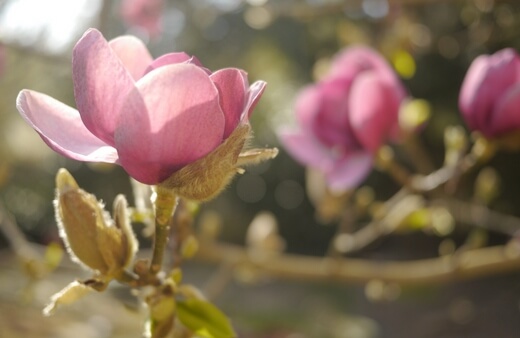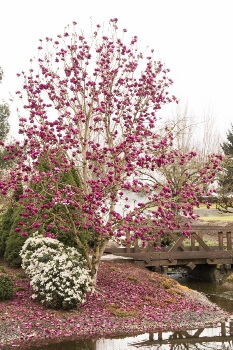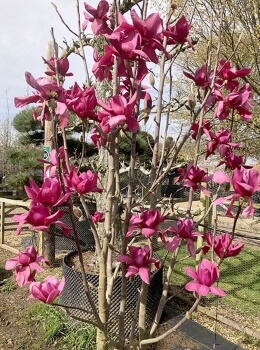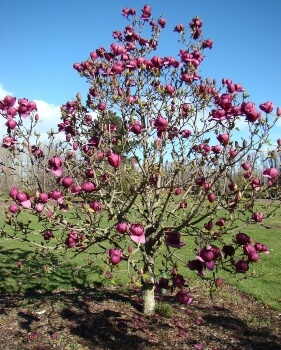When I think of the name magnolia, I think of spectacular bright flowers, and the colour of sunshine. This plant family is certainly known for glorious blooms and Magnolia ‘Black Tulip’ is no exception. The name feels like it has a bit of mystery to it too.
In our how to grow guide, we’ll talk you through how to propagate your own Magnolia ‘Black Tulip’, how to care for your plant and what pests and diseases to be on the lookout for.
More...

Family: | Magnoliaceae |
|---|---|
Genus: | Magnolia |
Hybrid: | Magnolia ‘Vulcan’ x Magnolia 'Iolanthe’ |
Common Name: | Magnolia ‘Black Tulip’ |
Location: | Outdoor |
Type: | Shrub or small tree |
Growth: | Up to 6 metres tall and 3 metres wide |
Sun requirements: | Full sun, part sun |
Foliage Colour: | Dark green |
Flower Colour: | Deep purple |
Flowering: | Spring |
Fruit: | None |
Maintenance level: | Low |
Poisonous for pets: | No |
Introducing Magnolia ‘Black Tulip’ Tree
This is an absolutely gorgeous dark purple magnolia – the flowers are shaped like a tulip and are a deep purple colour. They also have a lovely scent. Magnolia ‘Black Tulip’ can be a shrub or small tree, and it flowers at the beginning of spring.
The flowers are quite big at around 15 cm, and what’s lovely about this magnolia is that it usually blooms for a lengthy period of time. Sometimes you might be surprised by another round of flowering in the middle of summer.
Magnolia ‘Black Tulip’ can be used to create a hedge, but is equally well planted in a large pot. This particular hybrid of magnolia comes from New Zealand and was made by combining the Magnolia ‘Vulcan’ with Magnolia 'Iolanthe’.
Don't miss our main Magnolia article to learn more about different varieties of Magnolia.
How to Grow Magnolia ‘Black Tulip’
How to Propagate Magnolia ‘Black Tulip’

Source: Monrovia
Propagating Magnolia ‘Black Tulip’ from Cuttings
You can propagate your own Magnolia ‘Black Tulip’, by taking a softwood cutting either during spring, or early in the summertime. The length of the cutting should be around 15 to 20 cm.
Once you’ve got your cutting, take off the leaves on the lower part and make a vertical cut of around 5cm in the stem. You can dip the cutting into some rooting hormone before planting it in perlite that’s been moistened.
Give the cuttings sufficient water and then cover them with a plastic bag to create a greenhouse effect. Put the pot or planting container in a warm place with indirect light, and then remove the bag about twice a week to give the cuttings some air.
They will need to have sufficient moisture until they have rooted properly and if you give them a regular misting, you should see roots within a few months.
Once the roots have established themselves, the Magnolia ‘Black Tulip’ cuttings will need a hardening off period and can then be planted outdoors from the middle of autumn to the middle of spring.
Magnolia ‘Black Tulip’ Propagation by Air Layering
Another way that you are able to propagate a Magnolia ‘Black Tulip’ is a process called air layering. This involves cutting an existing branch and then packing a moist growing mixture around the cut so that roots are able to grow from it.
If you would like to give this method a try, the beginning of spring is a good time and do it with branches that are about a year old. You can make a cut parallel to each other in a circular pattern around the branch and space them just under 4 cm apart.
Join the lines by making another cut and take off the bark. Get hold of some coconut coir, wet it, and then wrap it around the cut you’ve created. You’ll probably need to secure it in place. You’re then going to put a layer of plastic wrap over the moss and tape it in place.
Be sure to keep the moss wet enough and when you eventually see roots sticking out of it, you can remove the cutting from the main plant.
Magnolia ‘Black Tulip’ Care Tips

Source: Majestic Trees
Sunlight Needs
The black tulip magnolia can grow well in either full or part sun, giving you options for your garden needs.
Watering Schedule
Magnolia ‘Black Tulip’ needs deep watering often, especially for the first couple of years. This helps it to create a healthy root system. Once the plant is established, you don’t need to water as often, but when you do, make sure it’s a good thorough watering session.
Soil
Your Magnolia ‘Black Tulip’ needs a well-draining soil. It should have plenty of organic matter, have even moisture levels, and be acidic. The plant does not enjoy wet or heavy soil.
Pruning
The ideal time to prune your Magnolia ‘Black Tulip’ is at the end of winter or end of summer. This helps the plant not to bleed sap. Pruning should be kept to a minimum and just enough to keep the desired shape of the shrub or tree.
Fertiliser
Magnolia ‘Black Tulip’ will need a general purpose fertiliser applied ahead of the spring when new growth begins.
Common Black Tulip Magnolia Problems
Scale
Scale is a well-known pest because it’s known to affect so many plants. These insects are sap sucking and take away from the nutrients that your plant needs to thrive.
If you are dealing with a light infestation, you can simply prune the branches that are affected and be sure to check your plant well for any pests that might be hiding out.
You can also use rubbing alcohol on a cotton bud and put it directly on the bugs to kill them off. A great preventative measure is to spray your plant with something like neem oil at the end of spring as the new leaves appear.
Coral spot
This is a fungal disease that results in the dieback of branches. Once the branch has died, you’ll see coral colour spots form on the surface. Try and prune only when the weather is dry and cut branches at the collar at the base of the branches.
The cut will heal more quickly here and minimise the chance of infection. If you do notice that die back is happening after you have pruned, get rid of any dead plant parts so that the infection doesn’t spread.
Any infections should be quickly pruned out so that spores can’t spread to other parts of the garden.
Honey fungus
This fungus got its name because of the honey colour mushrooms it produces. These usually show up at the end of summer or in autumn. The fungus spreads underground and then kills off the roots of plants.
Signs that you might be dealing with honey fungus are plant dieback, leaves that look pale, a lack of flowers, and bark that is cracking and seeping. It can be tricky to spot honey fungus because it spreads under the soil. It also doesn’t always produce mushrooms which are a giveaway sign.
There aren't any chemical treatments available to treat this fungus so you’ll have to get rid of the infected plant, roots and all. Be sure to inspect any neighbouring plants as well in case the fungus has managed to spread further.
There are a few things that can help minimise the spread of honey fungus and watering and pruning your Magnolia ‘Black Tulip’ well is important. You can remove a soil layer around the base of the plant as anything planted very deeply is more at risk. You can also dig the soil to up roots and break any infected roots.
Phytophthora root rot
One of the common signs of Phytophthora root rot is that the older leaves turn purple and red. You might also notice that the bark is a darker colour. Stunted growth is another sign.
If you are looking for a treatment, you could use a 3% solution of household hydrogen peroxide to treat your soil. You use a mixture of 1 part peroxide to 3 parts water.
You should allow enough time for it to really get into the soil before you start watering again. Another useful fungicide is anything containing copper as this also helps to protect the plant from infection.
Magnolia ‘Black Tulip’ Frequently Asked Questions

Source: Ecolife Plants
Why does my Magnolia ‘Black Tulip’ keep dropping its leaves?
This is completely normal as magnolia leaves turn yellow and drop off when they are old. This usually happens in the springtime when flowering starts. In some years, the magnolia will drop off more leaves than others and don’t worry if it seems like a large quantity of the plant’s leaves.
What is the best fertiliser for a Magnolia ‘Black Tulip’?
We recommend a multi-purpose 10-10-10 fertiliser.
Is Epsom salt a good thing to feed to Magnolia ‘Black Tulip’?
Magnolias need their magnesium as much as they need enough water. Epsom salt is a great source of magnesium for your plant.
Why is my Magnolia ‘Black Tulip’ not flowering?
The trick to getting a magnolia to bloom is to make sure that the soil pH is right. The Magnolia ‘Black Tulip’ needs a pH between acid and neutral.
How long does a magnolia live for?
Some species of magnolia can live between 80 and 120 years. The oldest known tree that was ever recorded was 320 years old, and was found in Italy.
Is the root system of the Magnolia ‘Black Tulip’ deep or more spread out?
The Magnolia ‘Black Tulip’ has an extensive root system but it doesn’t grow very deep. The roots grow outwards instead of downwards, so they are quite close to the surface of the soil.
Looking for more gardening advice and inspiration? Subscribe to our newsletter for regular tips, tool and plant reviews, and all things gardening inspired.
Looking to add more magnolias in your garden? Check out our growing guides below:
Wrapping Up Our Magnolia ‘Black Tulip’ Growing and Care Guide
Magnolia ‘Black Tulip’ is diverse in its garden uses – you can plant it as a border or in garden beds, display it on your patio, or grow it in a pot. It will attract birds and butterflies to your garden, and bring much joy, but also provide you with a great collection of cut flowers that can be used to decorate your home. I’m giving the Magnolia ‘Black Tulip’ my green thumbs up!
Published on February 21, 2023 by Maisie Blevins
Last Updated on February 23, 2024





Good morning,
I am hoping you can help my magnolia. I have had for approx. 3.5 years but it struggles to thrive or flower It is in a large pot in a favorable climate, I think. Your help would be so appreciated. It's heartbreaking.
Thank you.
Vanessa
Hi Vanessa,
It’s worth checking before I give any other advice, but do you know if it’s rooted well where it’s planted? Magnolias are really simple to keep happy, but only when they’re reasonably well established. Getting them to establish can be tricky.
If you can wiggle the base of the tree or its root ball at all, I’d suggest pulling it up and making sure the soil is draining properly beneath it (you can check nearby soil if you don’t want to risk this).
The other thing to note, is that magnolias respond quite badly to being moved. I had a magnolia in a pot when I first moved into my house, and it was doing really well… until we planted it.
After planting in the ground, it took about four years to start flowering properly, which is actually quite normal, but can be really frustrating, and upsetting, especially with trees that should provide a centre piece to the garden like Magnolias.
Hopefully, it resolves itself in time, but feeding it with soil improver or leaf mould as a top-dressing every year will help to either aerate poorly drained soil as well as feeding it, so is worth trying too.
Fingers cross this helps but do let us know if there’s any problems around the roots or with the soil, and hopefully I can give some more specific advice.
Best regards,
Gary Clarke
Hi Gary,
Thanks for your response. Unfortunately the plant is in its own large pot. Bit nervous to pull it out! Have looked after soil and given a spray of Yates Anti Rot.
She is alive but not flourishing after more than 3 years.
Any help would be welcomed by all.
Thanks,
Vanessa
Hi Vanessa,
If you’re not willing to pull it out of the container, maybe check the drainage holes at the base (if it’s not too heavy), if it’s established, it should have rooted after three years, at least to the point at fine roots have made their way down there.
Otherwise, I’d suggest giving it a good mulch of any organic compost, well-rotted manure, or leaf mold you can get your hands on. Yates Anti Rot is only really useful if it’s showing signs of fungal infection, or if its leaves are yellowing and/or dropping. Stick to organic mulches to feed it naturally, and slowly.
After three years, even if it has rooted, it will have probably exhausted most of the nutrients in its container, so mulching with good organic materials will give it a much-needed boost, and hopefully see it back in flower next spring.
If the soil is too close to the rim of the pot, just scrape a few inches of soil away, and replace it with the compost or organic mulch.
Best regards,
Gary Clarke